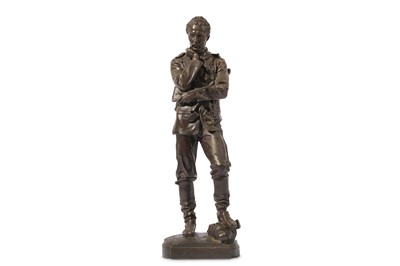26th Sep, 2019 10:00
Fine European Works of Art and Clocks
SIR WILLIAM HAMO THORNYCROFT (ENGLISH, 1850-1925): A BRONZE FIGURE OF GENERAL GORDON depicting standing at ease, with one foot resting on a broken cannon. his chin sunk in his right hand and his left hand clasping his pocket bible, tucked beneath the left arm his short cane and at his back a pair of field glasses, dark brown patination, signed 'HAMO THORNYCROFT R.A. SC 1888' to the base, the front inscribed 'CHARLES GEORGE GORDON', the reverse inscribed 'PUBLISHED BY ARTHUR LESLIE COLLIE, 39B OLD BOND ST LONDON MAY 6 1889' 36cm high Major-General Charles George Gordon, CB (1833-1885) Gordon of Khartoum, was a British army officer and major figure in military history, glorified at the time by the Victorians as a great hero. He began his military career in the Crimea, on the front line mapping Russian trenches, which was one of the most dangerous and demanding duties at the time. He was present at the siege of Sevastopol and was awarded Chevalier of the Legion of Honour by the Government of France in 1856 for his services. His next post was in China as part of the Allied Expeditionary Force that was fighting the 2nd Opium War. Having made peace with the Chinese Emperor he was made commander of the "Ever Victorious Army," a force of Chinese mercenaries led by European officers that defeated the Taiping Rebellion, a victory which lead to him being known as 'Chinese Gordon'. He reputedly led the E.V.A. into battle carrying nothing but his cane, whether true or not this idea of Gordon as a brave and almost nonchalant character certainly added to his heroic reputation at home and is alluded to in the present composition where he is shown deep in thought, holding his cane rather than a rifle or other arms. His cane became known as his 'wand of victory'. The full scale monument to General Gordon was designed after his death in Khartoum; there was a great public outpouring of grief and the public office decided to erect a statue in his honour. Several members of the Royal Academy advised that the monument should take the form of an allegorical subject, however this advice was ignored and the Office of Works formally commissioned Thornycroft to produce the statue. It was to be erected in Trafalgar Square at a cost of £3,600. The ten foot eight inches high bronze figure was to be raised on an elaborate pedestal eighteen feet high (3.3 meters and 5.5 meters high respectively). The whole aspect of the statue explained Thornycroft, 'I wished to be resolute, solitary, but not sad'. The monumental bronze was cast by the Thames Ditton foundry under the direction of James Moore. It was no coincidence that the sculptor selected this foundry, as Moore had been a foundry assistant to Thornycroft during the 1870s and had maintained links with the sculptor over the following years. Gordon is depicted in a crumpled army jacket, his belt undone and lacking a sword or weapon, ignoring all of the usual conventions of how to depict a military figure. This arguably expresses Gordon's dislike of bloodshed and the human suffering of war, he is instead portrayed as thoughtful, and with bible in hand, saint-like, his cane as his attribute. In 1943 the London statue was removed from Trafalgar square and now stands at the Victoria Embankment. We Know that Thornycroft produced his own reductions of the monument because records show that in 1889 he exhibited a bronze reduction of General Gordon at the Royal Academy, marked for sale at £10.The sculptor was praised at the time by both 'Portfolio' and 'Magazine of Art' for reviving an interest in sculpture among the art loving public, by producing reductions of the famous monumental works of the day, the artist was allowing those 'with shallow purses and narrow homes' to benefit from his work. 'Magazine of Art' wrote 'If sculpture is to become a popular art, there can be no doubt that it will become so through the publication of reductions of well-known works such as these'. The present bronze was cast as part of a series of works in 1889 by Arthur Leslie Collie. This small series of limited edition bronze reductions of famous works also included Onslow Ford's figure of 'Peace' and were sold at Collie's gallery. Auction Compararble: Bonhams, London, lot 274, 21 June 2016 for an example of this edition. A large seemingly unique bronze cast was sold in these rooms on 24 May 2017, lot 143, £25,000. Museum Comparable: Another cast is in the Ashmolean Museum, Oxford. Related Literature: S. Beattie, 'The New Sculpture', p.187 - 191 and p. 203 - 206.
Sold for £3,400
Includes Buyer's Premium
Do you have an item similar to the item above? If so please click the link below to request a free online valuation through our website.













